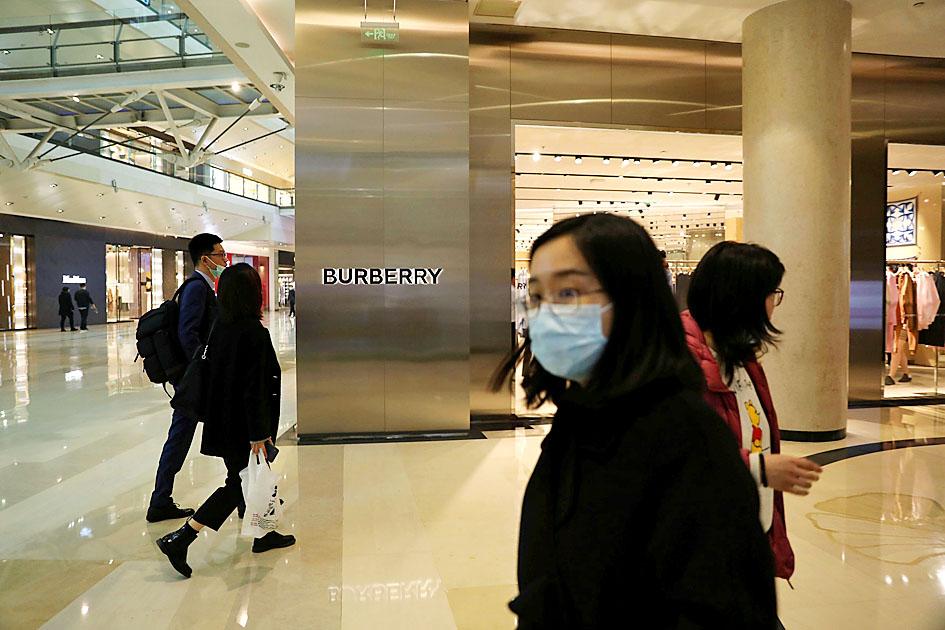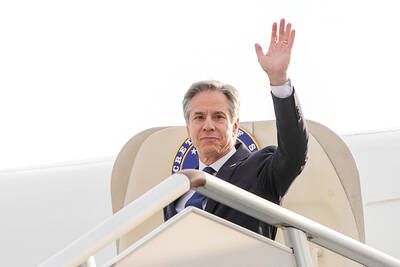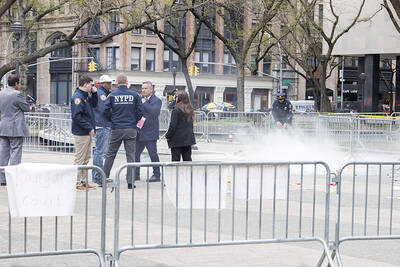It is the world’s biggest market for luxury goods — and their counterfeits — so an expert eye for telling a bona fide Chanel handbag from a bogus one is a skill set in hot demand across China.
Enter the “luxury appraiser,” an eagle-eyed differentiator of real from fake, trained to triage handbags, belts and garments for dodgy serial numbers, stitching and logos.
China’s factories churn out huge quantities of luxury goods, much of which is destined for a domestic market worth about 4 trillion yuan (US$618 billion), data provided by market researchers UIBE Luxury China showed.

Photo: Reuters
The country’s second-hand luxury market is also booming, as those unwilling to part with tens of thousands of yuan for a handbag seek out the prestige at a discount price.
However, a vast shadow trade in counterfeits lies in wait for the bargain-hunters.
Many are fooled by “good imitations with little difference” from the originals, said Zhang Chen, founder of the Extraordinary Luxuries Business School, who tools his graduates with the gift of detecting fakes.
His seven-day course teaches students how to detect forgeries, value second-hand goods and learn the skills needed to appraise luxury products.
While the course’s fee is 15,800 yuan, Zhang said that it is a price worth paying as it provides a foothold in a second-hand luxury market that is only just taking off.
China’s second-hand luxury market value last year reached 17.3 billion yuan, almost double the previous year, consultancy Forward Business Information said.
“Chinese people buy one-third of the world’s luxury goods, but the circulation rate of 3 percent is far below the 25 to 30 percent in Western countries,” Zhang said, referring to the percentage that is later resold.
Zhang drills the rules of luxury into students who are hooked onto his every word.
“The lining of a black Chanel handbag must be pink,” he said.
Trainees check ID cards on handbags from the French luxury fashion brand under a special ultraviolet light.
“Two letters will light up, and that’s the secret,” said Zhang, who learned his own skill appraising luxury goods a decade ago in Japan.
Knowing which letters in the Chanel logo use a rectangular rather than square font can “detect one-third of the fakes on the market,” he added.
His students are all affluent, but from a variety of backgrounds, including the former editor of a fashion magazine from Shanghai and a bartender looking for a fresh start after his business was hit by the COVID-19 pandemic.
“I realized that second-hand luxury bags could be sold at a very good price,” a 31-year-old stock market trader said.
A Louis Vuitton Neverfull handbag bought two years ago can still be sold at 9,000 yuan on second-hand platforms, a 20 percent discount, while a small Chanel Gabrielle bag goes for about 60 to 70 percent of the counter price.
“I think the logic behind the sales is very similar to the financial products I’m selling now,” he added.
However, the condition of the bags can have a heavy impact on value.
“Pay special attention to the scratches around the buckle, as a lot of people get manicures these days,” Zhang said, identifying grazes from long nails.
Seasonality is also essential, with red — the color of good luck in Chinese culture — selling quickest during holiday season.
His school has even attracted former counterfeiters as students, Zhang added, adding that many of them wanted to build on existing skills, but shift to less disreputable work.
In most cases, it takes Zhang about 10 seconds to tell if a product is real, he said, holding up a genuine Hermes bag.
Some clients send pictures of watches, shoes and clothes for an online diagnosis.
Verifying luxury products is set to become more high-tech with fashion houses introducing chips to trace pedigree.
Louis Vuitton in 2019 announced that it would launch a blockchain platform called AURA to record its goods.
Microchips have been inserted in the sole of women’s shoes made by Italian brand Salvatore Ferragamo, while Burberry has experimented with radio frequency identification technology in its goods.
However, with the technologies still in their infancy, Zhang is unconcerned about the threat to his analogue line of work.
“Any technology has the possibility of being cracked,” Zhang said. “The market for identifying luxury products will always exist, it’s just that the methods will have to adapt.”

‘IN A DIFFERENT PLACE’: The envoy first visited Shanghai, where he attended a Chinese basketball playoff match, and is to meet top officials in Beijing tomorrow US Secretary of State Antony Blinken yesterday arrived in China on his second visit in a year as the US ramps up pressure on its rival over its support for Russia while also seeking to manage tensions with Beijing. The US diplomat tomorrow is to meet China’s top brass in Beijing, where he is also expected to plead for restraint as Taiwan inaugurates president-elect William Lai (賴清德), and to raise US concerns on Chinese trade practices. However, Blinken is also seeking to stabilize ties, with tensions between the world’s two largest economies easing since his previous visit in June last year. At the
Nearly half of China’s major cities are suffering “moderate to severe” levels of subsidence, putting millions of people at risk of flooding, especially as sea levels rise, according to a study of nationwide satellite data released yesterday. The authors of the paper, published by the journal Science, found that 45 percent of China’s urban land was sinking faster than 3mm per year, with 16 percent at more than 10mm per year, driven not only by declining water tables, but also the sheer weight of the built environment. With China’s urban population already in excess of 900 million people, “even a small portion

UNSETTLING IMAGES: The scene took place in front of TV crews covering the Trump trial, with a CNN anchor calling it an ‘emotional and unbelievably disturbing moment’ A man who doused himself in an accelerant and set himself on fire outside the courthouse where former US president Donald Trump is on trial has died, police said yesterday. The New York City Police Department (NYPD) said the man was declared dead by staff at an area hospital. The man was in Collect Pond Park at about 1:30pm on Friday when he took out pamphlets espousing conspiracy theories, tossed them around, then doused himself in an accelerant and set himself on fire, officials and witnesses said. A large number of police officers were nearby when it happened. Some officers and bystanders rushed

Beijing is continuing to commit genocide and crimes against humanity against Uyghurs and other Muslim minorities in its western Xinjiang province, U.S. Secretary of State Antony Blinken said in a report published on Monday, ahead of his planned visit to China this week. The State Department’s annual human rights report, which documents abuses recorded all over the world during the previous calendar year, repeated language from previous years on the treatment of Muslims in Xinjiang, but the publication raises the issue ahead of delicate talks, including on the war in Ukraine and global trade, between the top U.S. diplomat and Chinese